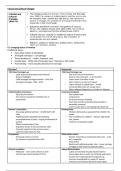4 Social and Cultural Changes
4.1 changing status of women
Traditional views:
Girls often victims of infanticide
Arranged marriages – concubinage
Three obedience’s – father, husband, sons
Uneducated – 1930s only 1% females over 7 literate vs 30% males
Foot binding – more sexually attractive for marriage
Elevated Depressed
1950 New Marriage Law 1950 New Marriage Law
- Legal equity (hold property/seek divorce) - Men lost financial investment
- Dowries forbidden - Divorce rates increased – 1.4m by 1953
- Child/arranged marriages banned - 1940 30% - Lower status of mother-in-law
arranged marriages, 1966 = 0.8% - More violence as men lost respect
- Cadres refused to uphold laws – feared
unrest/hostility/only rich would marry
- Other religions disagreed e.g. Muslims in Xinjiang
Collectivisation/communes Communal Canteens
- Equal pay for women - Poor quality food
- Iron women reward for matching men in - Long journey
productivity - Increased womens hardship
- Given less food if you did less physical labour =
inequality remained
- Lower income due to not making hats/boots etc
Women’s association Kindergartens
- Encourage political activism – 40,000 staff in 83 - Mothers distressed as separated from children for
cities weeks
- Published books/pamphlets proclaiming - Poor conditions for children – disease, high death
accomplishments of party + urging involvement of rate, famine
women - Teachers not properly taught
- Official membership of 76m
- Organised classes to increase literacy rates
- Financial support to help women weave
uniforms/make shoes for PLA
Propaganda Work points system
- Portrayed women as heroic - Women received less work points than men – m10,
- E.g. Women Locomotive Diver film w8 = inequality
- Disincentive
- Reinforced traditional gender roles – lower earnings
so might as well return to domestic duties
Cultural revolution Abuse/discrimination
- Politicised – wore same uniform as men - Cadres overworked/sexually abused women –
- 16-21% party cadres female 1970-74 miscarriages due to work, loss of family unit meant
women were separated from husbands e.g.
secretary investigated for raping 27 women
- In Hunan, some women forced to work naked
, Change in education/employment Military
- 100% completed primary educated by 1959 - Girls who could join the military were aimed to
- Unmarried, educated girls could join PLA 1949 marry male soldiers
- More job/travel opportunities
4.2 Education and Health provision
Education:
min pan schools – 64m children attended so increased access to primary schools, but 78% population
remained illiterate 1952 and only 52% attended primary schools in 1949
increased gvt investment in education – late 1950s-60s shows progress – 100% primary aged kids in full time
education = increased literacy rates. Around 30,000 schools by 1960 = 1 per commune = increased access
1951-52 42m peasants attended winter (adult) schools
63% students in engineering/medicine/agriculture
more university attendance due to easier admissions – boosted expertise in science/technology = skilled
workforce/more control for CCP
lesser focus on exams, more focus on practical work – fieldwork/military service alongside learning to create
skilled workforce
schools attached to factories became top rated w difficult entrance exams = meritocratic – only brightest
pupils from all backgrounds supposed to attend, however it ended up being children of key gvt/party
members = ‘two tier system’
political education/propaganda/history of workers being exploited – increased loyalty to Mao’s regime
introduction of Pinyin language 1955 – higher literacy rates, became uniform language from 1958
May 1959, strict limits on change to curriculum/teaching methods
Cultural revolution closed down many schools/unis as they promoted ‘bourgeois values’ - education system
essentially collapsed
People not sent back to schools - ‘up the mountains and down to the villages’ campaign – change in attitude
towards a focus on work rather than education e.g. Zhang Tie sheng
Healthcare:
Aims/problems to solve Policies to achieve this results
Prevention of disease rather than Cadres trained to teach peasants Smallpox/cholera/typhus/typhoid
cures about sanitation – dug deeper wells, fever/plague almost fully eliminated
removal of human waste
addiction Terror campaigns against drug Lower number of drug addicts
suppliers/criminal gangs
Greater access to healthcare Barefoot doctors through 1968 1.5m barefoot doctors (trained as
cooperative health scheme = mobile paramedics for 6 months)
medical support 150,000 fully trained doctors 1960
compared to 40,000 1949
Limited provisions for dealing w
serious illness
Inadequate rural hospitals = rural-
urban divide
Lower infant mortality/higher Women's federation increased the Increased fertility, decreased infant
maternal health education of midwifes/encouraged mortality
sterile, safer childbirth





